






Despite a height of only 10.95mm, the C60 Trident Lumière is impossible to ignore from your wrist. Day or night. This is due to its proudly protruding indices and logo they encircle. Featuring facets finely machined to tolerances of 0.03mm, these mini-monoliths are super-legible during daylight hours.
But it is Globolight®, the unique luminous ceramic from which they’re hewn, that produces their super-brilliance at night. And inspired this timepiece’s name. The light show doesn’t end there. Sculpted from titanium, the 41mm case incorporates a second sapphire crystal displaying its super-accurate movement. But it’s not the back of this stunning tool watch you’re thinking about. Is it?
Do your research christopherward.com

Christopher Ward is watchmaking’s original ‘challenger’ brand.
So, as we celebrate the release of The C12 Loco, this issue of Loupe is dedicated to those with the underdog spirit.
Matt Bielby’s profile of The Loco – and our first-ever documentary – shows CW at its rebellious best: overcoming the odds to create an exquisite horological instrument. From Maidenhead, we travel to New York in 1978 via an extraordinary set of photos taken at disco’s top nightclub, Studio 54. Then to Wembley stadium and one of football’s biggest upsets: Wimbledon’s victory against Liverpool in the FA Cup final of 1988. And don’t forget the final part of Ken Kessler’s history of the mechanical watch revival.
As usual, there’s plenty more for you to enjoy, but I’ll leave that to you.
Enjoy the issue!
Editor: Anthony Teasdale
Art Director: Jamie Gallagher
Designer: Sam Burn
Photography: George Simms
The Yard, 14-18 Bell St, Maidenhead SL6 1BR christopherward.com

We are ‘Loco!’
This time in 2005, we were closing in on the launch of our first watch, the C5 Malvern Automatic.
Dave Malone, a lecturer at the University of Tasmania and renowned watch expert, told his many followers on Timezone.com that he’d discovered “the best value mechanical watch the world has ever seen”.
Unknowingly, Dave had sounded the starting gun to a journey that led to the release of our most ambitious and audacious watch, The C12 Loco.
We decided The Loco should be breathtakingly beautiful, and have extreme reserves of power and astonishing accuracy. This required a brandnew movement with one of the finest balance wheels in watchmaking. The mesmerising motion of these wheels suggested the watch’s name, as did the insane scale of the challenge we set ourselves. Dave would expect nothing else!
Mike & Peter
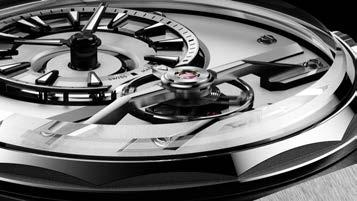



Christopher Ward has become the new Global Timing Partner of Men in Blazers, the largest media network in USA soccer.
The partnership will see the creation of four unique series, plus one-off experiences for CW fans.
“We’re delighted to be joining forces with Men in Blazers,” says Mike France, Christopher Ward CEO. “With the US being our largest market, this partnership is a natural next step in bringing CW to an even wider audience. Given our shared passion for football it was also a no-brainer for us.
Men in Blazers has a truly fresh approach to content, and we’re looking forward to seeing what we can create together.”
Men in Blazers was founded as a podcast by Roger Bennett and Michael David in 2010. Like Mike France, Bennett comes from Liverpool and is a lifelong Evertonian. “We admire what Christopher Ward has built, and the creative style in which they’ve built it,” says Bennett. “We have so much in common and are elated to be able to partner as trusted storytellers to produce, talent, and distribute the authentic, and meaningful stories they want to share with the American Men in Blazers audience.”
“This is a great deal for us, Men in Blazers and our fans,” says Mike. “Keep an eye out for updates from us!”



Letter from Biel

The latest news from our Swiss HQ
In this issue, Jörg Bader Jr is joined by supply chain director, Paul Wright.
JB: As you’d expect much of the work over the last few months has been around our new open balance watch, The C12 Loco. Happily, we’re handling it well.
PW: We’ve seen an earlier integration of the supply chain into the process, so we’re better prepared than we’ve ever been for a major launch.
JB: That’s not to say it’s been easy!
PW: Obviously, there’s been challenges, not least a request in January (or should that be ‘demand’) for 50+ samples/ pre-production for launch! The saying: “We can do the impossible but miracles are beyond us,” springs to mind.
The second British Watchmakers’ Day – organised by the Alliance of British Watch and Clock Makers – took place at Lindley Hall in London, in March, and Christopher Ward was once again at the centre of the action.
The day began with a little cheeky promotion for the limited edition C1 Moonphase ‘Mission to Maidenhead’ as a video- billboard van toured London’s West End – including a stop outside one well-known Swiss watch manufacturer.
At Lindley Hall, Christopher Ward fans flocked to our stall wearing new, old and rare CW pieces – including last year’s BWMD Bel Canto 9324.
“While last year’s event felt like a party, the 2025 event was confirmation just how much the British watch sector has grown,” says Mike France, CW CEO. “Having talked to the other brands in the hall, it’s so heartening to see how strong the link is between brands and fans – we really feed off each other.”
All proceeds from the sale of the ‘Mission to Maidenhead’ went to the Alliance of British Watch and Clock Makers, of which Christopher Ward is founder member.
JB: The process has been different from Bel Canto because we’ve started with a much stronger knowledge base.
PW: It’s not just the engineering side of things that has stepped, but the entire operation in Biel. The office is now bursting at the seams, but everyone is adapting brilliantly and the additions to the team are fitting in well.
JB: The team is stronger than ever. We’re in a great place to deliver what our customers expect. And Paul – who’s English – is adapting to the Swiss way of life.
PW: Being in Biel so frequently is giving me a chance to practice my French. And as the days lengthen, I’m looking forward to getting back on my bike and exploring the trails and woods surrounding the town. I might even make it to the top of the Chasseral mountain one day!
A new charity, supported by Christopher Ward, aims to tackle the suicide crisis in the construction industry, and ex-Everton footballer Trevor
Steven is playing a leading role

Working in construction is known for the toll it leaves on the human body. And while physical injuries are rarer than they used to be, poor mental health is endemic, with one in four workers saying they’ve thought about suicide.
Ex-Everton footballer Trevor Steven learned about this through a friend and is now heading Mindflow, a charity which aims to reduce the rate of suicide in the building industry by using footballers to spark discussion around mental health.
With Christopher Ward now supporting Mindflow as part of the 2% for GOOD initiative, Trevor talks to Loupe about what the charity hopes to achieve.
Hi Trevor. What’s the story of Mindflow?
In 2019, I became friends with an entrepreneur called Phil Brown who was involved

in a documentary called Howard’s Way about the Everton team I played in under manager Howard Kendall. One day, he’d been travelling on the motorway, and Mike Salla of Everton in the Community (EitC) was on Radio 5 Live, talking about how there are two suicides per day in construction. Phil said to me, “Wouldn't it be great if we could save a life.”
Phil had set up a building software company called Causeway, which helped fund The People’s Place – a purpose-built mental health hub with Everton. We’ve now formed a charity from that, Mindflow – supported by EitC – as a way to address the suicide problem.
How did you start?
I went to building sites around the country armed with a survey about mental health which I asked 1,500 workers to complete. It took 16 months. We liken the macho environment of a building site to the macho environment of a sports dressing room where it’s ‘survival of the fittest’.
What’s the link with football?
Sixty-seven percent of the people we interviewed were football fans, rising to 90 percent in some places, which is about 1.3mn in total. Everton in the Community says there are 30,000 Everton fans in construction. With one in four males admitting to thoughts of suicide, this means 7,500 Evertonians may have considered ending their lives. We use football as a way to help these men open up about their feelings.
As Mindflow launches, what’s the plan?
I’ve put a team together of former players – who we call ‘local heroes’ – to share their stories in presentations to workers. We encourage workers to look out for each other because mental health is invisible. As a male it can be hard to talk to your family about mental health, and especially in the workplace, but when we normalise conversations around this topic, things improve.

“One in four males have thoughts about suicide”
How will you achieve this?
We’re creating the Mindflow Charter, which has an aspirational 11 principles for the construction industry to adopt. Management will set the tone on every site – and we’re looking at consistency of delivery in a healthy environment.
Did you have problems with your mental health when you were playing?
You have your ups and downs –especially when you’re injured. When you’re playing you can still be isolated: you travel to work, stay in hotels, and there’s exposure to alcohol. But in football you get a pat on the back if you win. You don’t get any recognition in construction. Great football managers create environments where people thrive. Line management is so important. You should listen and be empathetic.
What’s the future for Mindflow?
Hopefully, with the endorsement of our charter, and broad implementation across the industry. It’s a five-year goal – but we’re definitely on our way!
For more on Mindflow, go to www.mindflow.charity

Christopher Ward commissioned its first documentary, which is now available for fans to watch on our YouTube channel. Freewheelin’, directed by CW collaborator Ben Anderson of Ursus Productions, follows CW teams in Biel and Maidenhead as they developed The C12 Loco open balance watch.
Over the last year, two camera operators filmed thousands of hours and footage – as well as interviewing some of the biggest names in watchmaking about the rise of CW and the impact it’s had on the global watch market.
According to the company’s new chief operating officer, Sarah Baumann, the result is a feature with a distinctly wartsand-all vision. “It’s unusual to let the cameras in and genuinely want them to show the truth,” she says. “But given the twists and turns of The Loco, we thought this had the potential to be an entertaining story about what it’s really like on the inside.”
You can watch Freewheelin’ on Christopher Ward’s YouTube channel Find out more about Freewheelin’ on page 24.

Christopher Ward has announced the sponsorship of Primary Engineer, a not-for-profit organisation on a mission to engage both primary and secondary school pupils and teachers with the world of engineering and technology. The deal is part of the company’s 2% for GOOD programme which gives 2 percent of all proceeds to CW’s selected charities.
Dr Susan Scurlock MBE is the founder of Primary Engineer. She says: “I founded Primary Engineer in 2005 and over the years worked with the team to develop many programmes aimed at inspiring all young people with and towards engineer-
ing careers. I firmly believe that all children should have the opportunity to engage with engineering as a right! And that due to that be able to achieve their potential.”
For CW co-founder Peter Ellis, the sponsorship is an investment in the future of British engineering. “If we’re serious about nurturing British watchmaking then it’s important to help charities like Primary Engineer. Of course, it’s not just about watchmaking, anything that improves UK engineering is good for the country as a whole.”


Ever since its launch in 2014, Christopher Ward’s first in-house movement has provided the base for some of the company’s most memorable watches. Now, Calibre SH21 is at the heart of the watch unlike anything produced by Christopher Ward before.
“We’re teaming up with one of the coolest brands in British watchmaking on a unique timepiece,” says designer Will Brackfield. “We’d been friendly for a while, so when we approached with the idea of a collaboration, they were quickly onbaord.”
“At first, we were thinking of doing a GMT together, but that didn’t fit with the vision” says Will. “Instead they came up
with another idea that manages to be both ultra-modern and reassuringly traditional. If you’re a fan of old English watchmaking this is something you’ll love.”
As the watch is powered by Calibre SH21, it’ll have a five-day power reserve and be a certified chronometer. We can also reveal that it will feature Roman numerals on the dial. “What fans will like about the piece is that it’ll look as good at home as it will on the move. And it’s very colourful, too.”
The 100-piece limited edition watch will eventually become the ‘Alliance 02’ –and will be available only to members of the Alliance of British Watch and Clock Makers, with all profits going to the organisation.

The C12 Loco is Christopher Ward’s most ambitious watch to date – featuring a new in-house movement, the company’s highest-ever levels of finishing, and a dial design the watch world’s going to go mad for
Words: Matt Bielby

All mechanical watches are in some way ‘alive’ –but few more so than one with a visible balance wheel rapidly oscillating back and forth, and providing ongoing treat for the eyes. They highlight everything that makes a technical watch special: bold choices, constant motion, design as well-considered beneath the bonnet as above. The best of these see-through designs are fascinating, jaw-dropping vehicles for the imagination, a hypnotic treat from either side of the case. It’s an area Christopher Ward’s explored before – but never with this level of rebellious audacity and unflinching commitment.
“One industry insider described our new C12 Loco as ‘Bel Canto on steroids,’” says co-founder and CEO Mike France. “It’s called The Loco because the movement of the balance suggests locomotion – and it also reflects the crazy level of ambition it took to create it!”
Taking design cues from the hit Bel Canto, but feeling younger, fresher and more sporting, it’s hand-finished to an insanely high level – with the emphasis on depth and detail – and can hold its head high alongside £25,000 pieces from the world’s most storied makers. But at a Christopher Ward price point, of course.
And it just happens to contain what’s only the company’s second ever in-house
movement, a cousin to Calibre SH21 (soon to be renamed CW-001) called CW-003, designed by technical director Frank Stelzer. Sounds cool, right? But you don’t know the half of it…
Many open balance watches actually feature ‘tourbillons’ – it means ‘whirlwind’– and describes a method of mounting the escapement and balance wheel in a rotating cage, theoretically eliminating the minuscule impact of gravity pulling at the movement. First developed in the early 1800s – two horological giants, John Arnold and Abraham-Louis Breguet, were key in its development – they never look less than amazing, viewed through a window in the watch face. But then so do the similar but more everyday ‘open heart’ watches, which lack the cage of the true tourbillon, and so can offer the giddy excitement of a visible balance wheel without the need to charge such buttock-clenching sums.
“It’s the high-end indie brands who’ve really been taking the lead with open balance watches,” says Adrian Buchmann, Christopher Ward’s design director. “And there’s a real joy to them, in that you're looking at something in constant motion. They’re always fun, always alive, but with the best of them – and I count ours very much among that number – the whirring
balance wheel is only the centrepiece of some incredibly well-considered movement architecture, with many elements hidden and others exposed. If you know watches, just one glance at the back of our C12 Loco will tell you just how high-end it is – not only in the details, but the entire design.”
The story of The C12 Loco began in the wake of Bel Canto: a big “What’s next?” moment for the company, with all sorts of ideas floating around and the idea of a balance-focussed watch very much to the fore, but ill-defined, out of focus.
“Things became clearer, though, through a playful doodle of Frank’s,” says Jörg Bader Jnr, product director at Christopher Ward. “I noticed him sketching something during an overrunning meeting. Using Bel Canto as a foundation, he’d mirrored the 12 o’clock bridge at the 6 o’clock position, then added a balance wheel. The idea was simple but powerful: adapt this design using our in-house SH21 movement, and we could create something fresh and visually striking. It felt like a quick win – the perfect combination of simplicity and ambition.”
Even better, market analysis revealed an interesting gap. Yes, there were a few entry-level open balance watches –simple pieces from the likes of Tissot and


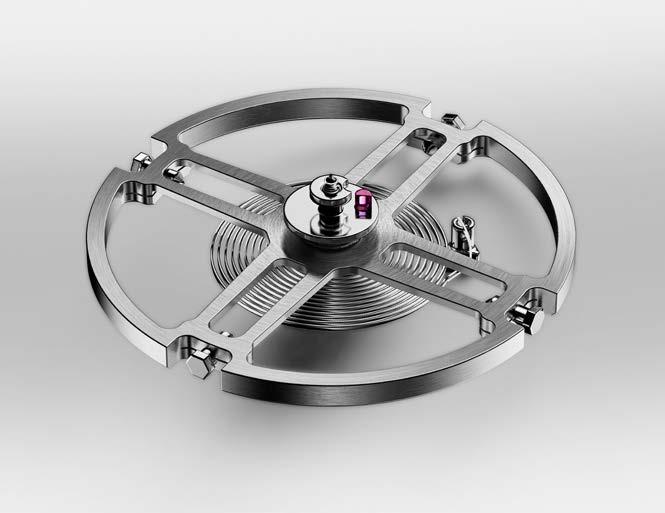
Only a unique, custom-designed balance wheel would do
Raymond Weil – but then there was a huge jump to more ambitious, complex and well-finished watches by a mix of ‘names’ (Zenith, Girard-Perregaux, Ulysse Nardin), cutting-edge indies (Armin Strom, MB&F), and brands that combine both. What if Christopher Ward could offer a design close to the latter but nearer the price point of the former? “What was missing was a watch to bring true value and innovation to the mid-range,” Jörg says. “And I felt that could be us.”
But not so fast, Jörg! Quick wins are rarely as easy as they first seem, and by the middle of 2023 things had evolved, but were becoming exponentially more complex too. Early designs had been a continuation of the Bel Canto aesthetic, but new elements kept being added, too. Could there be a small seconds hand? A power reserve indicator? And should we move the whole thing from the Bel Canto case to one based on the newly-released Twelve? Each new addition made sense, but together they were dragging the watch further from the beautiful simplicity that had made the concept so compelling in the first place.
Mike wasn’t sure. “It’s too cluttered,” he said. “Refocus. Take it back to its essence.”
And that was the push they needed. Out went the power reserve and small seconds, though the Twelve case stayed. By August 2023, 90 percent of the design was done – bold, clean, and true to the original vision, with strong horizontal lines and three distinct circles on the back. “Crack on,” Mike said.
Cracking on: a time of bold ambition and big decisions. And one huge realisation – that SH21, the starting point of the whole project, just wasn’t fit for purpose. To make The Loco really sing, a new movement would need to be created: one with elements in common with SH21 (both have twin barrels, for instance), but entirely different architecture and a recalculated energy flow. Born in part of the ambition to evolve Calibre SH21, instead it gave it a sibling.
“The look is crucial in a piece like this,” Jörg says. “We needed an exceptionally clean and clear mechanism that appears simple, even if the underlying complexity is immense. Just a neat, linear and symmetrical layout – which sounds easy, but is anything but.”
A new main plate would be necessary; that much was clear. With that, Frank could position the barrels on top of each other in perfect alignment, then place the intermediate ratchet wheel precisely at 3 o’clock. They’d need a new balance and winding bridge too; they’d also have to deal with the problem of transferring power: first from the mainspring barrels to the dial side, then from the 6 o’clock position through the centre to the balance.



“It’s hand-finished to an insanely high level”
Lots to think on then, and lots of inspired guesswork at every stage, for so much new stuff was being created at the same time. It pushed the design and product teams to their limits. (One example among many: putting the crown at 4 o’clock would have made life easier all round, but the team fought hard against it as it would have disturbed the purity of the vision).
The result, though, is quite something: a brand-new manually wound movement that’s perhaps the most impressive thing the company has ever done.
By October 2024, six watchmakers were testing prototypes, feeding back concerns: the bridges aren’t sturdy enough, causing the barrels to lift. Amplitude is low and irregular, but we don’t know why. So many details, but all boiling down to one key problem – the anchor bridge and pallets weren’t doing their jobs properly – and with this fixed, a major corner had been turned.
“The idea that drove the development of CW-003 was to clear everything away from the right hand side,” Adrian says. “Do that, and you can see just how big the barrels are, and how the bridges stand away from the base plate – all purely visual stuff, but crucial. With the winding mechanism hidden away, we’d only be showing the key visuals, as we’d done with Bel Canto.”
The two movements share perhaps 40 percent of their parts, though the new one’s more expensive to make, mostly because it boasts three small bridges on the movement side and two more on the dial side (to SH21’s one), which all need hand-polished facets. It’s essentially a one-shot creation, developed specifically for The Loco. “If nothing else, CW-003
shows just how far we’ll go,” Jörg says.
“If we can only do a brilliant job by creating something entirely new, then that’s what we’ll do.”
To no one’s great surprise, the elements the whole piece revolves around – the balance wheel and hairspring – were among the hardest to get right, and, unusually, are completely bespoke.
“Most of the time, standard parts appear in surprisingly expensive watches,” Jörg says. “The same commonly used balance wheels are made in their millions, for instance, and it’s not hard to see why: building new regulated systems is hard, and if you get it wrong – even a little bit – your watch simply won’t tell the time.”
But for this particular Christopher Ward, only a unique, custom-designed balance wheel would do, a rare free-spring version (usually a buzz word for quality) adjusted by tiny screws (rather than the more common regulating pins) that change the inertia of the balance wheel itself, rather than the length of the hairspring. Everyone who’s seen it agrees: it’s a most accurate and elegant solution.
“Without everyone pulling together, we simply couldn’t have done it,” Frank says. “Creating our own balance wheel was key to the whole thing, really – but I can now see why hardly anyone ever tries. Microscopic amounts of material had to be removed, then a little bit more, to achieve constant oscillation, a process that haunts my dreams. My great desire was always to create a clean, cohesive, fluid design that flows effortlessly from the front to the rear and back again, and it’s only immense dedication and great teamwork that’s made it possible.”
For a while, getting chronometer certification for the new movement had seemed crucial – but this style of watch demands no second hand, and without that to measure accuracy, no COSC. Fine, it was
decided: we don’t need it. “I suspect CW-003 far exceeds COSC standards,” Mike says. “But until we put it into a traditional three-hand piece, there’s no way to prove it for sure.”
So, what’s the finished Loco like? Well, it’s quite the beauty, as you can see. At 41mm across and 13.7mm thick (but looking thinner) with a remarkably short lugto-lug length, it wears easily on just about any wrist. The steel bracelet has a slim butterfly clasp, the hands are multi-faceted, and there’s linear brushing on the platine, while real screws hold everything together. The look and feel of the Twelve X has clearly been one starting point, but so has Bel Canto – The C12 Loco takes elements of both, has them meet in the middle, then moves everything forward three or four steps.
Tried-and-tested tricks like the use of box sapphire crystal and breaking up surfaces have been pressed into service to make the results feel as slim as possible, while the mid-case is built of two components, removing even the slightest hint of a slab side: as with Bel Canto, innovative CNC company Paoluzzo AG machined the new parts. Similarly, there’s no logo beyond those on the rear and the crown. “We love a clean look on these higher-end Christopher Wards,” Mike says. “And anyway, there’s really no good place for it to go.”
At the front, two main elements stand out. First is the floating time-telling dial at 12, taking up approximately half the real estate. It’s crisp, clean and easy to read, with lume on both hands and markers. You’ll have no problem telling the time at a glance, even with that flirtatious balance wheel just below it, so keen to draw the eye.
“To make The Loco really sing, a new movement would need to be created”

Power reserve 6 Days / 144 Hrs
Accuracy 0/+7 seconds p/day
Frequency 28,800 vph (4Hz)
“Plenty of what we learned on Bel Canto we’ve applied here, though on Bel Canto all the lines are curved,” says watch designer Will Brackfield, who took the lead on most of the design. With this one we needed to carry over the angular facets of the Twelve case to the bridges, so everything looks like it’s been cut with a katana sword – straight and sharp.”
Platine colours are punchy – “supercar shades”, says Will – with a choice of black, white, a striking blue and an even more potent metallic orange, somewhere between McLaren and Irn-Bru.
When you turn the watch over there’s even more to look at. The plates and bridges are deep black with fine grained and vertically brushed finishes, a backdrop against which everything else – in varying shades of silver – really pops. The
hand-finishing here – from old friends APJ Sarl – is meticulous, holding up to scrutiny under the most powerful loupes.
The modern breed of highly-technical floating balance watches are among the most enticing the industry produces, appealing to an audience awake to independent brands, and admirers of innovation, slick design and technical chops in equal measure
For Christopher Ward, it’s heady company. “Girard-Perregaux’s Neo Bridges, a £25,000 piece, is probably the closest watch to what we’re doing,” Jörg says, “while the MB&F Legacy Machine will always be a benchmark, as it’s perhaps the best known floating balance watch there is. Once again, though, we’re doing something in volume that nobody has attempted at similar numbers before.”

Availability: Open Series
Movement: CW-003
Dial colours: Alabaster White, Ursa Black, Pasadena Blue, Frisco Orange
Case: Stainless Steel
Diameter: 41mm
Height: 13.7mm
Lug to lug: 47.5mm
Water resistance: 3 ATM / 30m
Winding: Manual
Power reserve: 144 hrs
Jewels: 29
Timing tolerance: -0/+7 seconds per day
Frequency: 4Hz / 28,800 vph
The C12 Loco speaks to the wide-eyed seven-year-old in all of us, but at the same time edges Christopher Ward that little bit closer to the rarified world of avant-garde haute horlogerie – without the usual price points, of course. It also demonstrates a brand stretching itself, moving forward in interesting and exciting ways.
“I’m incredibly happy with it,” Jörg says. “The visual layering is exceptional, every element sitting on a different level, giving the entire watch a very architectural feel. It’s really modern, exceeds every expectation – and the price is amazing value.”
Not so long ago, the shocked CEO of a very large and very famous Swiss watch brand took one look at SH21 and asked, “What gives you the licence to do that?” “Just that we could,” came the answer. Who knows what he’d make of The C12 Loco?

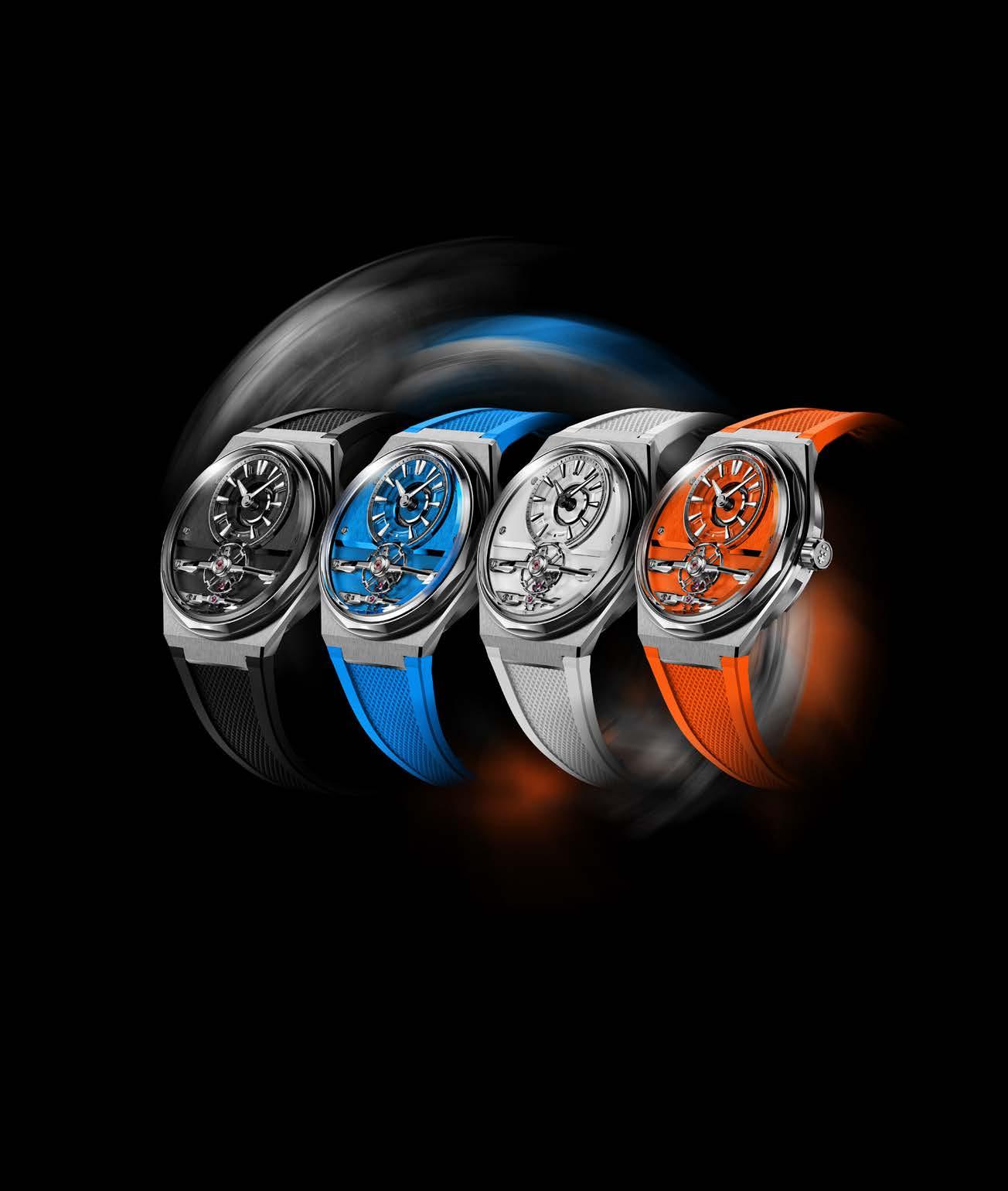
£3,795 / US$4,595 / €4,950
£3,995 / US$4,825 / €5,205

Transparency has always been a Christopher Ward virtue, and now Freewheelin’, a new feature-length documentary giving access-all-areas to the creation of The C12 Loco, will take you closer to the action than ever before
The C12 Loco isn’t just the most significant Christopher Ward watch since the Bel Canto but another sign that the company is inspiring creativity both inside and outside of its HQ. And nothing symbolises this better than a new fly-on-the-wall documentary, Freewheelin’
The film – whose name is a nod to the motion of the free-sprung balance wheel – follows the product team (Frank, Adrian, Will and the two Jörgs, Snr and Jnr) as they develop The Loco.
Gianluca Volpe, the brand manager spearheading the project, says the film is a story about a watch and the company that made it. “We follow Loco from initial concept to launch,” he says. “We’re keen to tell the CW story too – and, beyond that, examine the entire watch world. We’ve had two full-time camera operators working on it for months, Josh Bosley in
Maidenhead and Max Davies in Biel, and some of their footage is remarkable. ”
The film features players from UK watchmaking world such as YouTuber Andrew Morgan, journalist Laura McCreddie-Doak, Nicholas Bowman-Scargill – managing director of Fears Watch Company – plus celebrity watch fans like James McVey of The Vamps. Christopher Ward supporters are represented by insights from CW Forum moderator Kip McEwen and admin of the CW Enthusiasts Facebook group, Brian Hall.
The cameras also followed the CW team to New York for a night with Worn & Wound, where US customers got to interact with the company’s watches in the metal (and North American brand director Mike Pearson in the flesh). In the film, you’ll see W&W’s Zach Weiss and Blake Malin talk about the increasing impact Christopher Ward is having on the American market.
“Compared to the watch giants literally on the doorstep in Biel, Christopher Ward is a tiny team, yet it’s one rolling out exceptional new products,” says cameraman Max. “I’ve especially loved my road trip with Jörg Jnr, meeting with Adrian where we free-rolled a conversation about The Loco from the cobblestones of a little church, overlooking Lake Biel and miles of vineyards.”
While for his UK counterpart, Josh Bosley, “What’s been most amazing is seeing how everyone at Christopher Ward is so invested in what they do. There’s a genuine collective effort across all departments to get the best out of the products and champion the brand. And you get a sense that physically seeing, handling and appreciating a new product, in which so much time and energy has already been invested, never gets old.”

“The way we’ve grown has led directly to The Loco,” says company CEO and co-founder Mike France, “For this launch, the story seemed bigger than it usually does; it was the story of all of us, and where we’re going, and so had become just too important to cover with one of our regular minute-long videos. We needed to explain the brand and its place within the wider watch culture, and that demanded a few more minutes. Quite a few more minutes, as it turned out.”
Director Ben Anderson of Ursus Productions has made films for Christopher Ward, but never before of this length and ambition. “It’s almost 50 minutes long,” he says, “which it needed to be to tell the story, but for a very technical reason too: once you hit 47 minutes, you achieve ‘feature length’ status, and that puts you in a new ballpark.”
A ballpark that, for instance, will see the film become the centrepiece of a global campaign of launch events,
“For this launch, the story seemed bigger than it usually does; it was the story of all of us, and where we’re going”
communications and social media unlike anything Christopher Ward has attempted before.
Freewheelin’ will land at the same time as the watch on our YouTube channel,” Gianluca says. “And then – just perhaps – on additional platforms as video on demand. Before that, though, there’ll be a special cinema screening in London. We’re aiming for a film that works on multiple levels: it needs to appeal to watch enthusiasts, but also provide content compelling enough to engage those who aren’t ‘watch people’ themselves – not yet, at any rate!”
Though Mike appears in the film, he’s been keen to step back and allow those more directly involved in The Loco’s development to shine.
“You’ll see more of Adrian than you might expect,” Gian says. “Although he’s taken a backseat in Loupe of late, he’s always around, consulting with Will on designs. And Frank, I think, will be a revelation for a lot of people: he’s quietly funny, such a bright man, yet humble too. But for me, so far, the star of the show is Jörg Jnr: he’s just so endearing and enthusiastic about this watch, and much of the time he’s been the one who’s driven it forward.”
Beyond the core development team, others in the business appear too, those you may not have seen or heard from before. (Think: marketing, the dispatch team, customer services). This isn’t just the story of an ambitious, risk-taking development group, but of everything and everyone who makes a project like this possible. For new
chief operating officer, Sarah Baumann, creating this film has been a quintessentially Christopher Ward experience.
“We’ve been very strict with ourselves, and have refused to paint a pretty picture of the process,” she says. “I think it speaks volumes that we had the confidence to embark on such a long film. Brands can usually only sustain interest for a few minutes, but with an audience of watch enthusiasts it’s different.”
Rarely – perhaps uniquely – for the Swiss industry, Freewheelin’ shows all the moving parts. “It’s no-holds-barred and access-all-areas,” Gianluca says. “The Loco is something everyone’s proud of, and working on it has brought us closer together. In fact, we’ve all become part of its story.”
The final word goes to Sarah: “The filming will continue even after this issue of Loupe has gone to print. It’ll catch the twists and turns of the watch’s production, samples and launch. We won’t be afraid to show the most difficult moments. Even now, it’s all up for grabs!”
You can watch Freewheelin’ on Christopher Ward’s YouTube channel

Strap in for the extraordinary tale of Johnny Smythe: RAF navigator, prisoner of war and tireless campaigner for justice


If you were looking for the ultimate Boy’s Own adventure story, then the life of Johnny Smythe QC MBE(mil) OBE would fit the bill. Born in Sierra Leone in 1915, Johnny’s time on earth took in everything from the cockpit of an RAF bomber to a POW camp in Germany and Martin Luther King’s most famous rally –before retirement in Thame, Oxfordshire. Since Johnny died in 1996, his son Eddy has sought to preserve his dad’s memory, putting together an archive that tells the story of the great man’s life. Which is where Christopher Ward comes in. When a friend of CW CEO Mike France, who lives near Thame, told him about Johnny Smythe, he asked Eddy to be interviewed about his dad’s life.
Here, Eddy talks to Loupe about his father’s achievements, the impact he had on the world and the legacy he left.
Hi Eddy! Tell us about your dad’s early life
My father was born in Sierra Leone – as I was. He volunteered for the RAF in 1941 and joined Bomber Command. He came over and completed his training, and was immediately promoted to officer. Bear in mind, until 1939, the RAF had a colour bar as they didn’t believe black people were capable of flying planes. Even after

that, there was a huge reluctance to recruit from Africa. There were hundreds of thousands of volunteers, but out of a population of a billion, they recruited 60. Dad was one of those.
What was the link between Sierra Leone and Britain?
Sierra Leone was a British colony. But there’s a back story around my family. We’re from the Krios of Sierra Leone and are direct descendants from the times of slavery. When slavery was abolished, Britain sent groups of freed slaves from all over Africa to Sierra Leone. They spoke different languages, ate different food and listened to different music. And they all came together in a brand new culture with a brand new language. They emulated the British and dressed like them. They also built the first university in Africa and became highly educated. They were entitled to get British passports, and the British wanted them to spread Christianity. Therefore, there was an indelible link between the Krios and the British. So when the call came with World War II, my father volunteered. The RAF selected five Krios from Sierra Leone.
Did your dad always want to fly?
Not really. He joined a volunteer force when war broke out, saw the advertisement for the RAF, and applied. Then he was on a ship to England. He trained as a pilot, flying Tiger Moths, but because of his mathematical aptitude he became a navigator. He was posted to 623 Squadron in Downham Market, which flew the Short Stirling, the RAF’s first four-engine bomber.
Did he fly missions over Germany?
Yes, but he was shot down in November 1943. Despite being injured by shrapnel, he was able to parachute out of the plane and land safely but was captured when the smoke from his cigarette was noticed. He was brutally interrogated, and then sent to hospital where he had two ribs removed. Eventually, he was transferred to Stalag Luft 1 POW camp in Barth, where he was imprisoned for 18 months. After the war, a reporter asked him if he’d tried to escape. He smiled and said: “I did think about it, I could have lost myself by mingling with all the other 6ft 4in black men in Germany!”
What did he do after the war?
He went back to London. He was still a navigator and was seconded to the Colonial Office, whose job was to look after the welfare of the Caribbean men and women living in England. As part of the role, he was required to board the HMT Empire Windrush, which was taking a contingent of demobilised men back home.
What happened then?
The economy in Jamaica was poor at the time and unemployment was high. They didn’t have the jobs these men deserved and the Jamaican labour officer appealed to Britain for help. The Colonial Office told my father: “You’re the senior officer. You need to interview these men and come up with some suggestions.” So he compiled a report. There were engineers, farmers, factory workers, miners and others who wanted to join the military and reenlist in the RAF. He classified them and recommended they come back to Britain. The Colonial Office accepted his suggestion and that was the inception of the ‘Windrush generation’.
How did he get into law?
When he was at the Colonial Office, his role included representing men who were being court-martialed. He had no legal training but he was eloquent and articulate – and was successful in defending the men.
One of the judges asked my father for lunch, and asked him if he’d thought about law as a career. He said, no. The judge gave my dad an introduction letter to the Inns of Court in London. He was accepted and studied law there, and qualified as barrister. He married his wife – my mother, a nurse from Grenada – and they went

“He

‘I have a dream’ speech”
back to Sierra Leone. He rose to become solicitor general and then attorney general. He helped write the laws for the country’s independence and did a tour of the USA where he met Robert F. Kennedy, who was attorney general at the time. He was a guest of honour at the rally where Martin Luther King Jr did the ‘I have a dream’ speech, and was presented with a Gold Key to the City of Miami Beach by the Mayor. After leaving the government, he became one of the first black QCs [Queen’s Counsel].
What was he like as a barrister?
As a child I loved going to court to watch him in action. He was formidable. He both prosecuted and defended for the government, and defended privately with a high rate of success.
Do you have a favourite story?
When he was in private practice in Sierra Leone, he acted for a lot of embassies. One day he was at a cocktail party at the British ambassador’s house. The German ambassador came up to him and said; “Hey, Johnny, I hear you were in the RAF during the war.” And my dad said he was. “I was fighter pilot in the Luftwaffe,” said the ambassador. They started chatting
and the German ambassador asked him how the war ended for dad. “Well, on November 18th, 1943 I got shot down,” he said. The ambassador asked him, where. He said, “Meinheim”. The ambassador’s face paled and he said, “On that day I was flying and I shot down my first bomber!”
Was your dad angry?
No! They threw their arms around each other and laughed. The ambassador recommended he receive the Order of St Lazarus medal. He was proud of it. Only two Africans have received it: Emperor Haile Sellasie of Ethiopia and my dad!
Looking back on his life, what’s his legacy?
Over the last few years, there’s been a lot of interest in him, and I’m called upon to do talks and presentations at school, universities, the RAF, government councils, community groups, museums, libraries and the police. Last year, the local town of Thame – where he retired to – opened a permanent exhibition in the Thame museum. He’s now been honoured with a blue plaque, which will be placed in the last house he lived in in the town.
How would you sum him up?
He believed in justice. He was fearless. And never took a backward step when it came to telling the truth. A trailblazer!
You can find out more at john-smythe.co.uk
Studio 54nightclub inthelate1970sshow thecityasdecadent,playfuland celebrity-obsessedasever
They said you could hear the thud of the 4/4 beat at the Studio 54 discothèque before you saw it. And when you did lay eyes on Studio 54: the first thing you saw was the queue. Though ‘queue’ is not the right word – ‘scrum’ is more accurate. At Studio 54, the club of New York City in the late 1970s, you had to be incredibly famous or impossibly beautiful just to get past the bouncers.
Want to go in with your friends for a dance? Forget about it. Fancy a night with the rich and more-famous-than-you? Not tonight, schlub. Andy Warhol, Frank Sinatra and Liza Minnelli don’t want to share the air with ‘civilians’.
Even Nile Rodgers and Bernard Edwards of Chic, the disco geniuses whose records provided the soundtrack to Studio 54 were knocked back. They were so angry they went home and wrote a track called F*ck Off – which, renamed Le Freak –became a Studio 54 anthem.
One person who did get in was photographer Tod Papageorge. Between 1978 and 1980, he crossed the velvet rope and photographed Studio 54-ers in their halter-neck-andflares finerie. Now those images have been collated in a most desirable photo book, Studio 54
His images – taken on medium-format 6x9cm cameras – show New York at its most decadent. Beautiful men and women strut their stuff on the packed dance floors; celebrities
look for members of their tribe to talk to, and the inebriated seek solace in their drugs and drinks of choice.
“Only the famous or socially connected could assume they’d find themselves shooed around the flock of hopeful celebrants milling on the street side of the velvet rope and guided through the door,” he says. “Otherwise, the thing most likely to help was to be beautiful. Once inside, though, everyone there seemed thrilled by the fact, no matter how they’d managed it, an excitement fed by the throbbing music and brilliantly designed interiors, which, on a party night, could suggest anything from Caliban’s cave to a harem.”
There’s sadness here, too. Sadness that comes from knowing some of the young men in these images would soon fall victim to the AIDS epidemic that decimated the gay population in the 1980s – and which robbed the city of so many of its shining stars.
Studio 54, which Steve Rubell and Ian Schrager (now a hotelier) owned, defined the disco scene with the impeccable musical selection of DJs Nicky Siano and François Kevorkian. And though it closed after only 33 months, its legacy of hedonism and glamour lives on in every VIP room, luxury hotel lounge and members’ club we civilians can’t gain entry to.
Studio 54 is published by Stanley/Barker, out now







“It helped to be beautiful”

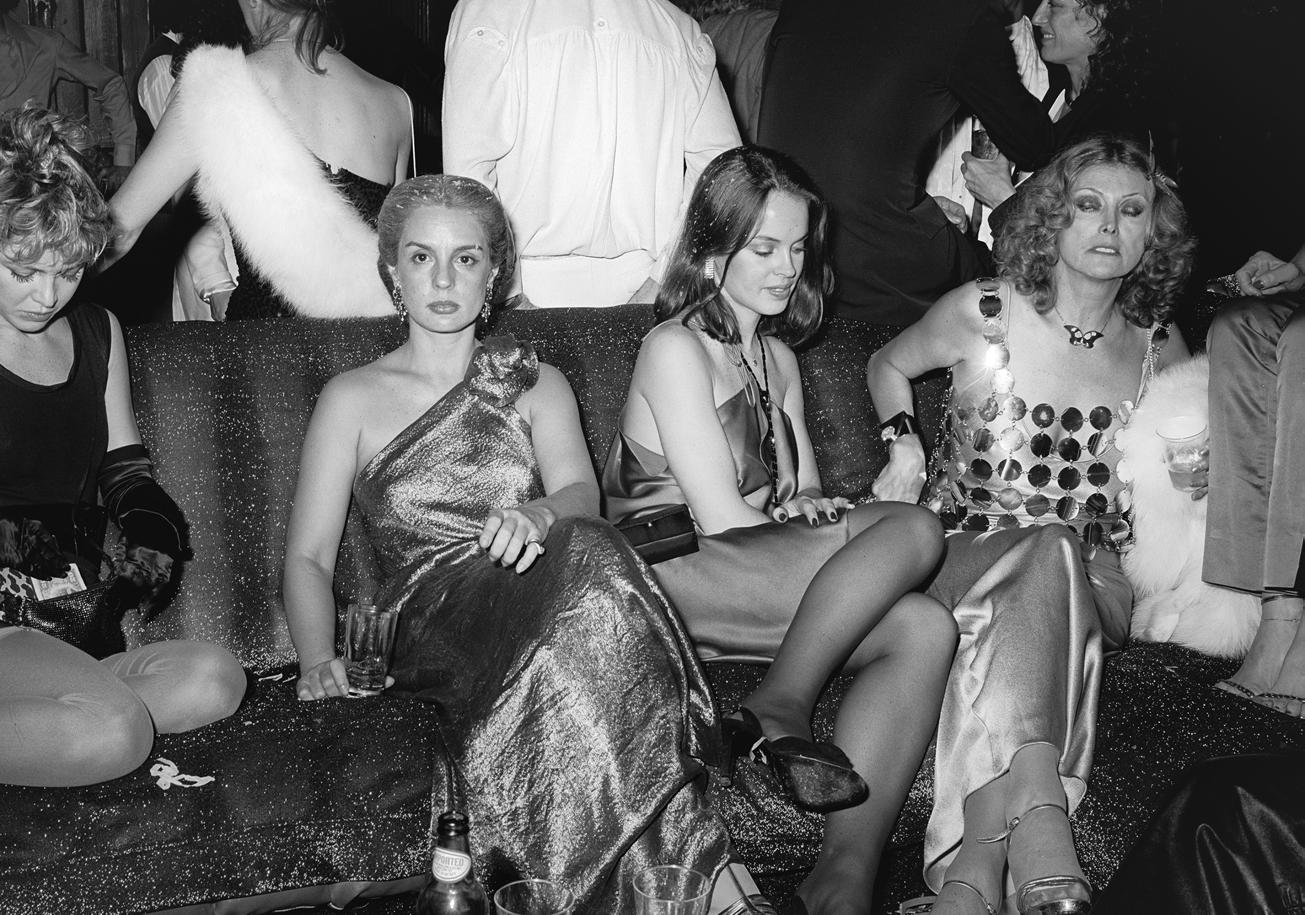


Fashion and jewellery is full of microbrands led by females, but the watch world has depressingly few. Why?
Words Laura McCreddie-Doak
It’s not news that the watch industry is dominated by men. However, a report unveiled at the end of last year compiled by Watch Femme, the Geneva-based non-profit association that promotes female voices across the watch world on women in watches concluded the inevitable – women are underserved at every level from CEO to consumer.
Aside from a lack of visibility, one thing did beg a question, especially after seeing content produced at a recent microbrand event where every single founder interview was male: why are there no, or rather so few, female-led microbrands in our industry? Fashion and jewellery – industries that could be considered ‘watch adjacent’ – have plenty, why is the watch world so poorly served?
“It’s true that women founders and designers are few and far between in the world of microbrands, and I think that’s explained by representation in the watch industry at large,” says Sarah Baumann, recently appointed COO at Christopher Ward and one of the few women occupying a senior position in a UK watch brand. “To create a diverse pipeline of founders, you need to have healthy diversity all the way up, but particularly at senior levels and over a number of years.”
Diversity is somewhat of an issue in the watch world and not just gender diversity either. However, to focus on the latter, women are being failed consistently. Take the easiest route into finding out about watches – the media. Broadly speaking men are first made aware of watches,

or used to be, before the rise of blogs, YouTube, Instagram and TikTok, through magazines. Even now, if you look purely at print media, magazines such as GQ and Esquire carry numerous watch articles on a monthly basis as well as rounding out the year with bumper watch supplements.
Of course, this is facilitated by advertising – the symbiosis between it and editorial is well documented – which is why the front of most men’s magazines have runs of well-designed double-page watch ads with an aesthetic carefully curated for maximum appeal. Women have none of that access. There is precious little proper, informative watch editorial in women’s titles, the knock-on effect of this is few adverts, let alone ones for which a marketing

“Women are underserved at every level from CEO to consumer”
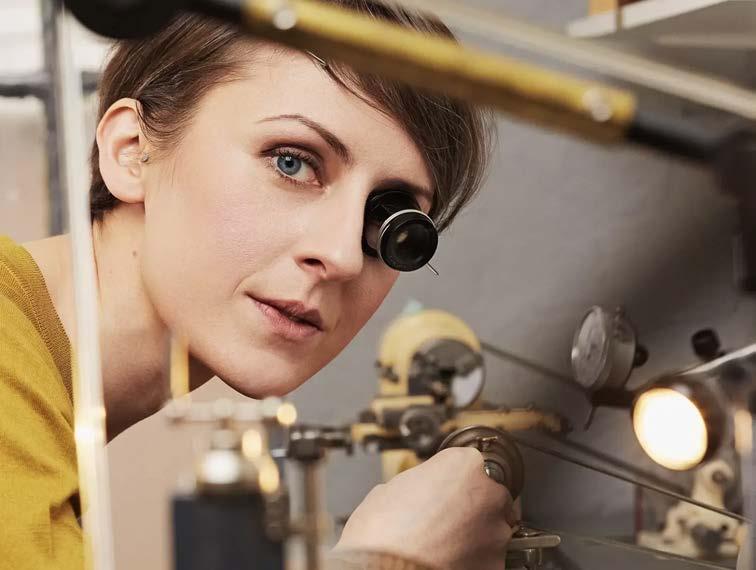
agency has actually put in any thought, which in that wonderfully circular way advertising and editorial work, means few watches on the product or style pages.
This, as Dr Rebecca Struthers, co-founder of Struthers London, author, and the only person to be awarded a PhD in horology, points out, has a direct effect on women thinking watchmaking or running a watch business is a viable career option. “There is a lack of support we get from a lot of the mainstream watch press and the lack of acknowledgement we receive from other watchmakers too,” she says.
“I’m so tired of seeing male watchmakers I know who slide into my DMs [‘direct messages’] asking for support, which I do, and share all our contacts etc, then whenever they’re interviewed their inspiration is a list of men. I can only remember one guy namechecking me as an inspiration which meant a lot! Press support seems to be limited to a few amazing journalists such as Tracey Llewellyn [global editorial director for watch magazine Revolution] rather than a concerted effort by the industry as a whole. Publications themselves should really be getting around a table to look for bias in their reporting.”
Independent watchmaker Fiona Kruger agrees. “Before I started my journey into horology, I didn’t think watches were ‘for me’,” she says. “This was more about how they were presented and talked about rather than not seeing other women in positions within the industry. The messaging didn’t resonate with me at all. It seemed like an exclusive world (and I mean that in the sense of a closed ‘club’), all about status, which I didn’t relate to.”
Representation aside, probably the greatest barrier to women wanting to set up microbrands is access to financing across the board. According to British Business Bank, the government-owned economic bank that helps businesses in the UK access finance, for every pound of UK venture capital investment, less than one penny went to all-female founder teams in 2019 (with 89 pence in the pound going to all-male equivalents). The view of women as risk-averse was cited as a contributing factor as many investors see risk-taking as part of a successful financial strategy.
“I’d say the struggle of setting up a business and accessing finance is a major factor as watchmaking companies are expensive to set up,” says Struthers. “They also usually take time to turn a profit so require an even higher degree of faith and understanding from lenders/investors.”
This is something with which Baumann agrees. “Building a successful microbrand is far from easy,” she says. “We have a thriving scene here in the UK – as evidenced by British Watchmakers’ Day.

“Building successful microbrands is far from easy”

It’s growing a new audience and helping to ignite people’s interest in both wearing, understanding and collecting watches, which can only be a good thing. But it’s not an easy undertaking, as all microbrand founders will attest, with a complex and expensive supply chain and a specific and small talent pool.”
This may feel like an impossible situation for women wanting to set up a watch business, however, there are chinks of light. The presence of high-profile women such as Struthers, whose book charting a history of humanity through timekeeping, Hands of Time, was featured on Radio 4, gives young female watchmakers someone to whom they can aspire.
Sarah Baumann too is proof that a female perspective is valuable at boardroom level, while at the major players, the likes of Carole Forestier-Kasapi, head of movement creation at TAG Heuer; Anne-Gaëlle Quinet, head of complications at Audemars Piguet, and Grand Prix d’Horlogerie de Genève (GPHG)-winning watchmaker and founder of Maison Alcée, Alcée Montfort, show that getting your head around how a balance wheel works isn’t just the preserve of the hairier sex.
“It’s an interesting question to consider what innovation and change more female founders and senior leaders would bring to the watch industry,” says Sarah. “In my experience there’s no doubt that women and other underrepresented communities bring new perspectives and tangible results to businesses – even when their primary audience is male.”
Baumann has a point. The watch world need only look at fashion, jewellery, and even her previous industry, advertising, where the inclusion of more women on creative teams led to blue liquid being retired to advertise sanitary products, to see how expanding the pool of talent can be revolutionary. What Sarah seems to be saying is that the watch world’s future could be bright, especially if it’s more female.
Culture that’s worthy of your time
Loupe editor Anthony Teasdale discovers a relic from a bygone horological age in Palma de Mallorca
It’s difficult to find a ‘traditional’ watch shop these days.
Not the mythical ‘ADs’ (‘authorised dealers’) of Instagram who you butter up for a year so you can finally get your hands on a Submariner. Nor the boutiques of Bond Street or Madison Avenue where you’re ‘welcomed’ by ex-forces doormen in skin-tight suits and made to feel like an imposter – which you are – until you finally crack and go to the pub.
But a regular shop on an ordinary street that happens to sell watches, clocks and horological ephemera? These are few and far between. But if you wander around the old town of Palma de Mallorca, east of the Plaça Major, you’ll find one.
Rellotgeria Catalana – ‘Catalan Watchmakers’ in English – has been selling watches in this part of Palma since 1915. The shop is a world away from the luxury stores we’ve got used to. A wide array of watches fill the windows in brand groups, but there’s little order apart from the professional-looking Seiko display.
In one window, you’ll find the sort of old-school Casio digital watches dinner ladies and school secretaries used to wear, while another plays host to Citizen dive watches, Bulova dress pieces and a collection of alarm, and wall clocks. This dedication to old-fashioned gadgets is a uniquely Spanish phenomenon: electrical

shops display irons like the latest iPhone, while grocers will stick a bottle of bleach in the window. “Señor, the rumours are true –we stock the famous Domestos!”
And yet, people flock to Rellotgeria Catalana. Workmen on their lunch break looking for a little horological diversion, watch snobs eyeing the Seiko ‘Cocktail Time’, and sometimes the editor of a watch magazine taking endless photos of the faded ‘SEIKO’ sign on the wall. Then there are the couples – often elderly – who just want to have a chat with the owners, a husband and wife team of some vintage who both sell and repair watches. Inside, all is varnished wood and glass cases. If you wish to sample a Seiko diving watch or avail yourself of a cuckoo clock (I’m not making this up), then Señor Serra – the original owner’s son – will take care of it. His wife will greet you and take care of the transaction.
There’s no real reason Rellotgeria Catalana should exist in 2025: the timepieces it sells can be found online, while alarm clock sales can’t be that healthy in the mobile phone era. And yet, here it is – thriving. Maybe it comes down to that most

old-fashioned of concepts: service – something which is still valued in Spain. Every town used to have a watch shop like this. My parents bought me my first watch – a Sekonda digital – at a jewellers in Southport, near Liverpool, in the late 1970s. As it was placed on my skinny wrist, I felt for the first time in my life, like a grown-up. This, like, buying your first suit, was a rite of passage. That’s no longer the case. So, finding a busy watch store on a back street in one of the most beautiful cities in Europe is a rare treat. The next time you go to Palma – and everyone should go to Palma – you could do worse than give Rellotgeria Catalana a visit. I’d recommend you look at the website beforehand, but, as you’ll be unsurprised to know, they don’t actually have one.
Which is exactly as it should be.

When you picture the quintessentially English county, there’s a fair chance you think of Oxfordshire.
While Yorkshire brings to mind crags, moors and dales, and Lancashire is basically one big city with Blackpool at its western extremity, Oxfordshire has winding lanes, ancient churches and green rolling hills.
This however, doesn’t mean it’s boring. Thanks to its proximity to London – and, of course, Christopher Ward’s HQ in Maidenhead – Oxfordshire plays host to an array of rated restaurants, country houses, world-renowned museums and enticing hostelries.
The county is now the subject of the latest guide by Weekend Journals, whose previous guides looked at Somerset, Cornwall and London. And, as with those, this guide to Oxfordshire delivers an array of

things to see, explore and consume that you probably don’t know about.
There are interviews with some of the county’s big cultural players, including Raymond Blanc, the French chef behind the must-visit Le Manoir Au Quat’Saisons hotel/restaurant, plus in-depth profiles of assorted wineries, arboretums and pubs. Lots of pubs.
But what makes the book such a coffee-table essential is the photography – vital in a guide aimed at “design-conscious travellers”. Even if you don’t plan to visit this part of the world, the shots of crumbling churches, cottages and country lanes will have you yearning for this most mythical and ancient corner of England.
Oxfordshire by Weekend Journals is out now











90:00
Football likes to call itself the beautiful game.
And if you were a fan of Liverpool in the 1987-88 season, you’d have nodded your head in agreement.
Because Liverpool played a brand of football that wasn’t just effective – they lost just two games all season – but also pleasing on the eye. Backed by the most solid defence in English football (and with Steve McMahon as a midfield ‘enforcer’), the attacking trio of John Barnes, Peter Beardsley and John Aldridge crafted exquisite goals that had more to do with Copacabana beach than Crew Alexandria.
If Liverpool were the purists’ favourite – Sir Tom Finney described LFC’s 5-0 win against Nottingham Forest as the “finest exhibition I've seen” – then Wimbledon were the opposite. Managed by Bobby Gould, Wimbledon had risen from the Southern League to the top tier in just 11 years. And they’d done so by winning ugly.
They had no choice. The Dons’ side was made up of journeymen who’d either been released by other clubs or previously made their living on building sites and in factories. With a reputation for playing practical jokes on each other and annoying other fans with their style of play, Wimbledon’s squad developed a ‘us v them’ mentality that made them difficult to beat.
By April the (pre-Premier League) Division One title was all but sewn up. Which, with English clubs banned from Europe after the Heysel disaster, left the small formality of the FA Cup Final for the Reds to win. 44
Come FA Cup Final day, May 14th, the press talk was not about whether Liverpool would win, but by how many goals. The sportswriters, however, hadn’t reckoned
with the meticulous preparation of Bobby Gould and assistant Don Howe, who’d focused on frustrating Liverpool’s attack – witness Vinnie Jones clattering Steve McMahon early on – and making the most of set plays.
In the 37th minute their strategy paid off. Liverpool gave away a free kick in their half, which was curled into the Reds penalty box by Dennis Wise. And there, while Liverpool’s squad were discussing whether they’d have meat or fish in the celebration dinner, up popped defender Lawrie Sanchez to nod it into the net. BBC commentator John Motson described it as a “typical Wimbledon goal”.
Well, this wasn’t in the script.
The rest of the game saw Liverpool lay siege to the Wimbledon half without
“The
club”

actually looking like scoring. But in the 60th minute they were awarded a penalty. Up stepped a visibly nervous John Aldridge – normally clinical under pressure – who chipped to the right of the goal in the perfect position for bubble-permed goalie Dave Beasant to save.
At the final whistle, the Dons players danced in celebration, while the legions of Liverpool fans sang You’ll Never Walk Alone in the hope they could change the result through the power of their anthem. Commentator John Motson declared that “the crazy gang has beaten the culture club” – and gave Wimbledon a nickname that perfectly summed up their footballing philosophy.
As someone once said, “football is a funny old game” – not just a beautiful one.


Ken Kessler concludes his account of the mechanical watch revival by looking at how the internet sparked an explosion in creativity from new producers, retailers and enthusiasts
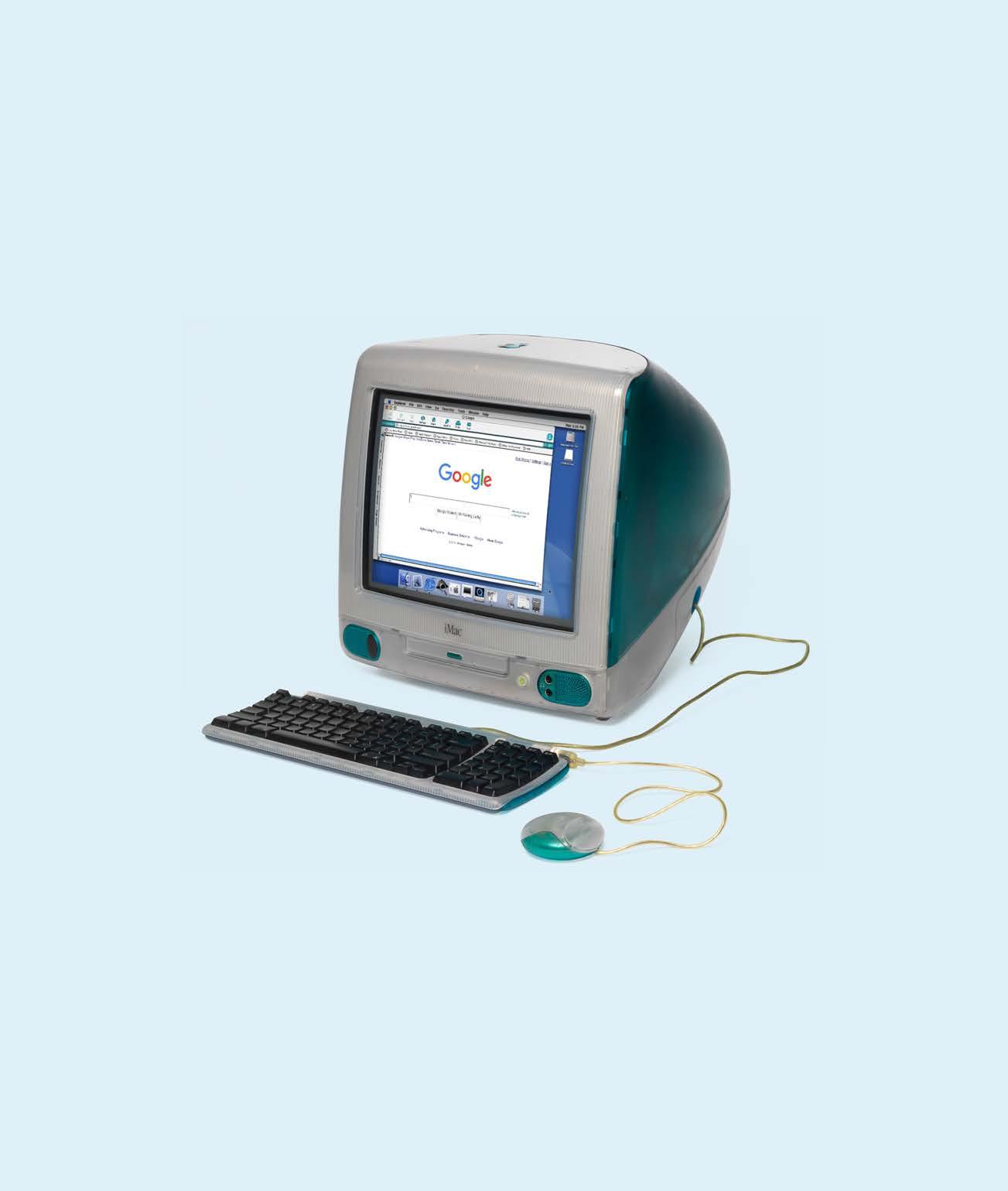
Thanks to being web-savvy after the mid-1990s, the plethora of all-new watch brands could address a whole new market: a fresh demographic of enthusiasts who did not necessarily feel any need to enter a boutique to buy a watch were happy to shop online. They had no need for the guidance of a salesperson because the internet would also sire innumerable, independent websites sharing horological knowledge. Everything from books to luggage to shoes to homes ultimately would be offered online, so why not watches?
While this was a contentious issue for extant, major brands with established networks of retailers – many that supported the watch manufacturers for a century-plus – it was not an issue for the all-new companies. To this day, most time-honoured, pre-Quartz Crisis watch brands sell exclusively through bricks-and-mortar establishments, whether via independent retailers, retail chains like Watches of Switzerland, the brands’ own boutiques or a combination of all three.
Newcomers, however, had no such restrictions, no need to address existing contracts or loyalties (and one wonders how long-term authorised dealers responded to suppliers closing them down after decades). This created an immediate benefit for the consumer. These direct-selling arrivistes, by eliminating both distributors and retailers, could afford to offer timepieces at prices roughly half that of equivalent watches sold through traditional outlets, which were penalised by one or even two added margins.
While today Instagram, TikTok and others are rife with watch-related postings, the deeper knowledge and, yes, provenance of the established websites now provide the most reliable information for enthusiasts, challenging print (as seems to be the case in every field of interest, alas).
It is generally believed that TimeZone started online watch sites back in 1995, and it remains one of the most respected. In its wake followed hundreds of watch-focussed sites including the best-established: Fratello (2004), Monochrome-Watches (2006), Watchionista (2009), Worn&Wound (2011) and especially Hodinkee (2008). The last-named is, by some margin, the most successful and is now part of the Watches of Switzerland Group.
Books were sold online
– why not watches?
This high-value-for-money formula also enabled the rebirth of the British watch industry, more of which anon. Equally, those who wished to sell both directly and via high street retailers have been wise enough to ensure that their online prices are the same as the retail cost in the shops. But that is a topic for another time.
Preceding the selling of watches online came the websites which predated social media as the means of communication for the growing watch enthusiast community.
In addition to these all-embracing sites are those devoted solely to individual brands. These fan-based efforts may not be factory-supported – some may even rile the brands they cover – but most dig deeper than the official sites, as obsessives do. Thus monomaniacal devotees of specific watches can find dedicated sites for Rolex, Audemars Piguet, Panerai, Patek Philippe, and many others.
In addition to sources found only online are those set up by print magazines that were wise enough to know that newsstand titles must have an online presence. Revolution Watch, WatchTime, Oracle Time, Orologi, Chronos and most others which began as newsstand titles have websites, as well as X and Facebook feeds. One of the most informative, as it’s aimed at industry professionals, is WatchPro, essential for enthusiasts and collectors who are also interested in the business side of the sector.
While all sources of horological information have an online presence, not all are equal. Official sites self-censor and might have a revisionist take on history, while personal sites hunger for hits – none are perfect. It’s clear, too, that more information is disseminated via the internet than was ever achieved by print.
Where they differ is that the print magazines are far more reliable (and remain that way) than independent
websites because print journalism is handled by editors responsible for every word before they reach print. Accountability is crucial for print magazines because they are easier to sue than websites. [If this sounds like an old fart talking, it’s because I see more factual errors or baseless, idiotic opinions every day on Instagram or TikTok than I’d ever seen in 40 years of reading Orologi, Polso, Chronos, Revolution, IW etc.]
Not long after the watch blogs, chat rooms, news and brands’ own sites appeared, so did vendors of pre-owned timepieces. If the major watch brands took their sweet time embracing the internet, pre-owned vendors did not. Unquestionably, the most important was Watchfinder, launched in 2002, though a number of small, independent watch specialists were online from the earliest days of the internet.
What Watchfinder offered was grading and fair pricing, the detailed descriptions recalling Antiquorum’s grading system for auctions devised in the previous decades. It launched the practice of a ‘buy-back guarantee’, now also offered by its online and storebased rivals, which refunded the cost of a watch if returned in good condition after two years, toward the purchase of another timepiece.
eponymous brand in 2001, after more than a decade under the tutelage of the legendary watchmaker George Daniels. Next came Bremont in 2002, with chronographs in the hotly-contested sector that included TAG Heuer, Longines and others – affordable but not inexpensive. Christopher Ward’s arrival in 2004 changed matters by exercising the aforementioned direct sales, offering mechanical watches at a fraction of that of equivalent Swiss timepieces, most with the same movements. Since then, the revived British watch industry has given birth to over 100 makes.
While still small compared to the Swiss, German or French watch industries, the return of British watchmakers was one of the better surprises of the last quarter century.
British watchmaking will not survive by living in the past
Again, it was a bandwagon on which to jump. Chrono24 added a new wrinkle in that it did not sell watches: it hosted vendors, private and professional, who displayed their wares on the site. More recently, eBay – probably the world’s largest online vendor of pre-owned goods – eliminated the risk of buying a dud or a fake by initiating a programme of inspecting and approving watches sold over £2,000, acting as a hands-on go-between amid seller and buyer.
The British are coming
As noted in Part III [see Loupe 35], nearly all of the new watch manufacturers which arrived from the mid-1980s to the turn of the century aimed directly at the high-end, or haute horlogerie. There were precious few exceptions. Even the rebirth of the British watch industry started at the extreme top of the market, when Roger Smith launched his
Specialists such as Roger Smith, Rebecca Struthers, Frodsham, Backes & Strauss and Garrick serve the exclusive end of the market, with severely limited production. For those who insist that a British watch must have its movement made entirely in Great Britain, these are the main brands likely to achieve this.
In contrast, most of the new-wave British watch brands have entered the affordable sector, and use either Miyota or Seiko movements from Japan or ETA, Sellita, Valjoux or others from Switzerland, or have, like Christopher Ward, established their own ateliers in Switzerland. At entry level, Seconda and Accurist wave the Union Jack. Prices then reach a few hundred pounds, before hitting most price points below £10,000 for brands including Bremont, Schofield, Bamford, Pinion, Farer and others.
A British name doesn’t always mean British watchmaking: one must respect the watches of Arnold and Graham, but they are entirely Swiss operations. If, however, horological precedents are important, the British watch industry has been served perfectly by the revivals by family descendants of Fears, Vertex, and Duckworth Prestex. But British watchmaking will not survive by living in the past –which makes Christopher Ward’s C1 Bel Canto winning the Petite Aiguille category at the 2023 Grand Prix d’Horlogerie de Genève (GPHG) all the more momentous.

Few people embodied the dark side of the American dream better than director David Lynch – who died aged 78 in January this year.
From his Twin Peaks TV series to the intense neonoir of Blue Velvet – and not forgetting the creepy Lost Highway – Lynch’s movies fused classic Americana with under-, and indeed, overtones of malevolence.
Lynch’s style matched those of his films. Mostly, he wore a boxy black suit with a white shirt, buttoned up to the top, without a tie. His hair was the classic American quiff – combed back from the forehead, like a hip-but-sinister music teacher.
And into this ensemble came his favourite watch, the Hamilton Altair. Released in December 1961 as part of Hamilton’s Electric series, the Altair has an asymmetric shape – similar to that of the Hamilton Ventura, a favourite of Elvis Presley. This lends the piece a mid-century sci-fi aesthetic, something enhanced by the minimalist design of the dial.
Another characteristic of the Altair is a rarity: only 1,600 were produced by Hamilton – all powered by the Hamilton 505 movement, a pre-quartz calibre that was revolutionary for its era. Lynch was lucky enough to find one of the ultra-rare black-dialled

While the Altair was Lynch’s signature watch, he also wore a ‘Flakey Yellow’ Swatch (Ref: GJ132) and a Jaeger-LeCoultre Reverso. Most exciting of all his watches, however, is the limited edition ‘Twin Peaks’ quartz watch by Vannen – which comes in two flavours; one with a ‘donut’ graphic on the dial, the other a top-down image of a cup of coffee.
And while this model doesn’t have quite the élan of the Altair, it’s exactly the sort of cheap-but-cool product he and his weird characters would have loved.


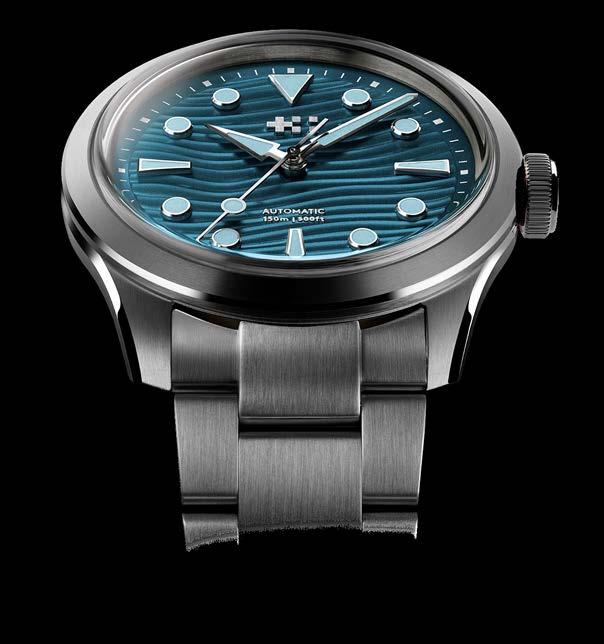
3000 years after the Egyptians invented the sun dial, we bring you a windinfluenced design. Inspired by topography they’d know well. The undulating face of the new Dune Aeolian captures a unique moment. A sand pattern carved by ever-shifting dune winds. Featuring freshly created hues of Eve, Marram, Silica and Sand, in steel. Or Marram and Dusk for (COSC-certified) bronze-cased versions, it elegantly passes muster. But with its ‘Goldilocks’ 38mm width, 11.9mm height, 150m water resistance, ‘strap monster’ 20mm lugs and vibrant luminosity, it’s at home in any field. Or desert. Starting from just £750 on leather, it’s well worth exploring.
Do your research

